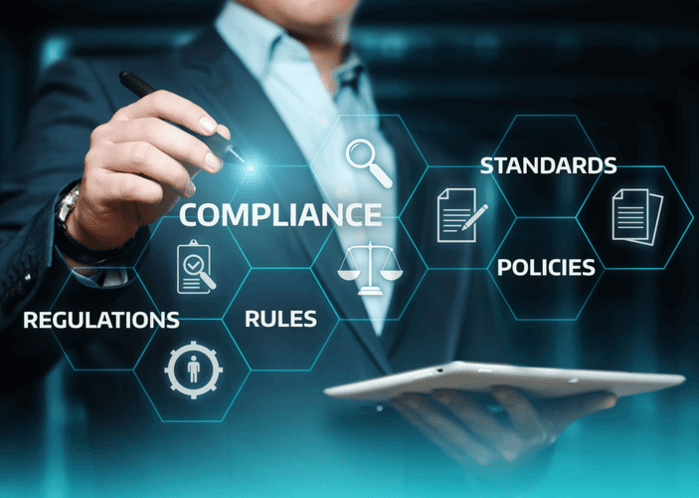Governance, Risk & Compliance (GRC)
Master Compliance, Mitigate Risks: Empower Your Strategy with GRC Excellence
Our Expertise
Governance, Risk, and Compliance (GRC) represents an organizational strategy aimed at overseeing governance, mitigating risks, and ensuring compliance with industry and governmental regulations. GRC may also denote an integrated suite of software functionalities designed for implementing and administering an enterprise with a GRC-centric approach. The practices and procedures encompassed within GRC offer a structured methodology for aligning IT endeavors with business objectives. Coined by OCEG (the Open Compliance and Ethics Group) in 2007, GRC aids companies in effectively managing IT and security risks, curtailing costs, reducing uncertainty, and meeting compliance mandates.
Additionally, it facilitates improved decision-making and performance by providing an integrated perspective on an organization's risk management practices. As small- and medium-sized enterprises increasingly operate on a global scale, both the risks and the imperative to adhere to governmental regulations assume a global dimension, necessitating vigilant attention to governance, risk management system, and compliance protocols.

Why GRC?
A GRC framework assists organizations in establishing policies and procedures aimed at minimizing compliance risks. GRC solutions in IT and security focus on harnessing timely insights concerning data, and infrastructures, as well as virtual, mobile, and cloud applications. Furthermore, an organization’s GRC system is expected to enhance efficiencies, mitigate risks, and optimize performance and return on investment (ROI). Businesses typically develop and utilize a GRC framework encompassing leadership, organizational aspects, and IT operations to ensure alignment with and facilitation of the organization's strategic objectives. This involves correlating information within the framework of business processes, policies, and controls, along with activities conducted by IT, finance, HR teams, and C-suite executives.
Efficiency
Compliance management, risk assessment, compliance risk management, and internal audits can become laborious and resource-intensive without the support of a GRC software platform. Implementing a GRC capability enables companies to dismantle process and data silos, eliminate redundant efforts, adhere to regulatory mandates, and monitor, assess, and forecast losses and cyber risk management events. Moreover, it facilitates the management of the lifecycle of financial and AI-driven models and enhances IT compliance and controls. Companies can even gauge the impact of business and regulatory requirements on policy frameworks and streamline automated measurement and IT controls through seamless integration with third-party products.


Risk Assessment & Reduction
GRC empowers companies to establish, automate, and oversee risk assessments and risk mitigation strategies. The data gleaned from a GRC platform enables companies to make more informed decisions and allocate resources effectively to mitigate risks. Within the realm of GRC, Enterprise Risk Management (ERM) specifically focuses on identifying and addressing risk factors, including compliance risk management and supply risk management. Regulatory audits, such as those mandated by the Sarbanes-Oxley Act, serve as pivotal benchmarks for GRC operations. Departments must uphold the safeguarding of sensitive information—including invoices, human resources records, and financial reports—to ensure readiness for these audits.
An effective GRC program proves particularly beneficial for companies that have previously encountered significant compliance or risk-related incidents. Moreover, businesses lacking confidence in their compliance measures, as well as internal and external financial risk reporting and visibility, or those grappling with third-party risk management issues, can turn to a GRC model to rectify and monitor redundant control sets and ineffective frameworks, thus mitigating recurrent risk concerns.
Strategic Support for Performance & ROI
Occasionally, companies may encounter challenges in resource allocation, conflict resolution, and performance evaluation. These difficulties often stem from the rising costs associated with addressing risks and meeting regulatory requirements, compounded by the complexities of managing the expanding network of third-party relationships and associated risks. Nevertheless, companies can effectively establish and track clear objectives using metrics derived from a GRC platform. This proactive approach aids in enhancing performance and optimizing return on investment (ROI).

Make the Most of It
- Content and document management helps businesses more accurately create, track, and store digitized content.
- Risk data management and analytics that help to measure, quantify, and predict risk—and determine the next steps to reduce it.
- Workflow management to help companies establish, execute, and monitor GRC-related workflows.
- Audit management to organize information and streamline processes for conducting internal audits.
- Aids for business units to coordinate their activities on a single platform.
- Connections to keep up-to-date on regulatory changes.
- Pre-built templates that enable quick setup and customization.
- A dashboard that provides a central interface where key performance indicators relevant to business processes and objectives can be monitored in real-time.
Featured Products

